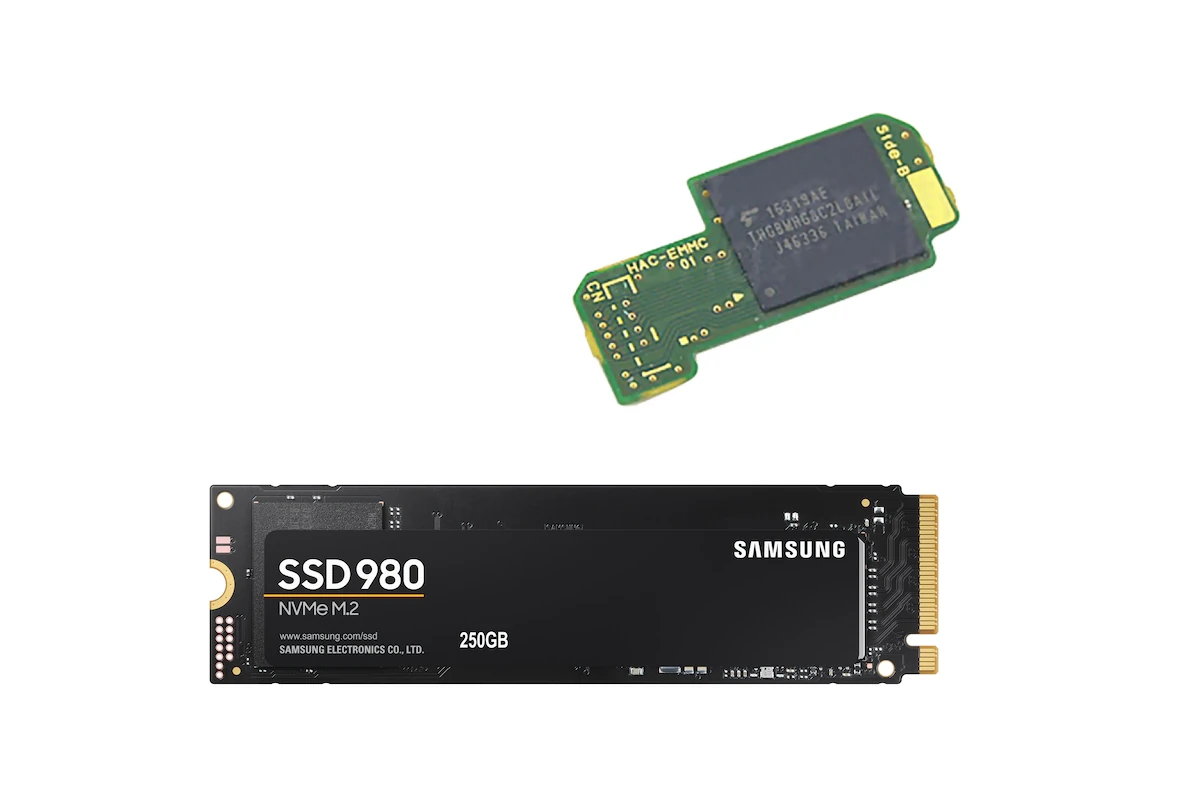When shopping for laptops, smartphones, or tablets, one critical factor to consider is the type of storage the device uses. Two common storage types are eMMC (embedded MultiMediaCard) and SSD (solid-state drive). Both types of storage use NAND flash memory to store data, but they have distinct differences. eMMC is often found in budget devices and is valued for its cost-efficiency, while SSDs are typically used in higher-end devices due to their superior performance.
SSDs outpace eMMCs with faster read and write speeds, making them suitable for demanding tasks and multitasking. This speed advantage is because SSDs may have multiple NAND gates, allowing for quicker data transfer rates. Despite this, eMMC can be a practical choice for devices where top-tier speed is not a priority, and the main aims are low cost or limited storage needs.
Understanding eMMC and SSD Storage: A Comparison for Consumers
Defining eMMC and SSD
eMMC (embedded MultiMediaCard) and SSD (Solid State Drive) are both flash memory-based storage technologies commonly used in modern electronic devices. They offer faster read and write speeds compared to traditional hard disk drives (HDDs). However, they differ in terms of their architecture, performance, and use cases.
eMMC is a type of embedded storage that is directly soldered onto the device’s motherboard. It is commonly found in smartphones, tablets, and some budget laptops. eMMC is a cost-effective solution for devices with limited space and power constraints.
SSD, on the other hand, is a separate storage device that can be connected to a computer or other electronic device through various interfaces, such as SATA or NVMe. SSDs are known for their superior performance, durability, and reliability compared to eMMCs. They are commonly used in high-performance laptops, desktops, and servers.
Key Differences between eMMC and SSD
The following table summarizes the key differences between eMMC and SSD:
| Feature | eMMC | SSD |
|---|---|---|
| Form Factor | Embedded (soldered onto the motherboard) | Separate storage device |
| Interface | eMMC | SATA, NVMe, PCIe |
| Speed | Slower | Faster |
| Capacity | Lower | Higher |
| Durability | Lower | Higher |
| Cost | Lower | Higher |
| Common Uses | Smartphones, tablets, budget laptops | High-performance laptops, desktops, servers |
Choosing the Right Storage for Your Needs
When choosing between eMMC and SSD, consider your budget, performance requirements, and intended use case. If you need a cost-effective storage solution for a basic device with limited storage needs, eMMC may be a suitable option. However, if you require high-performance storage for demanding applications or a device with ample storage space, SSD is the way to go.
It is important to note that SSD technology is constantly evolving, with newer and faster interfaces like NVMe and PCIe becoming increasingly popular. These interfaces offer significantly faster speeds than traditional SATA SSDs, making them ideal for high-performance computing tasks.
In conclusion, both eMMC and SSD offer advantages and disadvantages depending on your specific needs and budget. By understanding the key differences between these two storage technologies, you can make an informed decision and choose the right storage solution for your device.
Key Takeaways
- Storage type is vital when buying technology products.
- eMMC is cost-effective; SSDs provide better performance.
- The right choice depends on the device’s intended use.
Understanding eMMC and SSD Storage
eMMC and SSD are two types of storage used for saving files and running applications. This section breaks down what they are, how they perform, and why one might be chosen over the other.
Technology Overview
eMMC stands for Embedded MultiMediaCard. It is built using NAND flash memory and often gets used in mobile devices and budget laptops. SSD stands for solid-state drive. It also uses NAND flash memory but has more complex controllers for better performance.
Performance Metrics
The speed at which data is read and written is crucial. SSDs often have faster read and write speeds compared to eMMC. This means SSDs can transfer large files quickly. They also make devices start up faster.
Storage Capacities and Form Factors
SSDs come in larger capacities, going up into terabytes. Common form factors include 2.5-inch, M.2, and mSATA. eMMC storage is smaller, both in physical size and capacity. They are found on a single chip inside smaller devices.
Price and Cost-Efficiency
eMMC is more affordable. It suits devices that do not need top speed like some laptops or budget smartphones. SSDs cost more but offer better speed and capacity. They are worth it for tasks that need fast data access.
Use Cases and Device Applications
eMMC is enough for web surfing, light apps, and streaming media. SSDs are better for gaming, video editing, and applications that need high performance. They get used in gaming PCs, workstations, and high-end laptops.
Durability and Lifespan
Both eMMC and SSD have no moving parts. This makes them tougher and they last longer than hard disk drives. Still, SSDs usually have a longer lifespan. They better handle wear and tear since they manage storage with more advanced technology.
Upgrading and Futureproofing
Upgrading storage with SSDs is common. They can be switched out and upgraded easily. eMMC is often soldered to the device’s motherboard which makes upgrading difficult. Choosing SSD can be better for future needs.
Comparative Analysis
When comparing eMMC and SSD, SSDs usually stand out with better performance in speed and durability. eMMC’s advantage lies in its lower cost. It’s a good choice for less demanding tech tasks.
Market Trends and Predictions
SSD technology is progressing with new standards like PCIe 4.0 and NVMe. These offer even faster speeds. eMMC stays popular in budget devices. Market trends point to SSDs growing in use as prices drop and devices require more speed.







